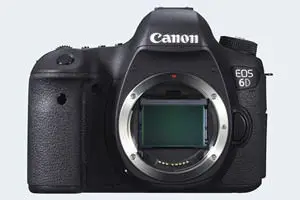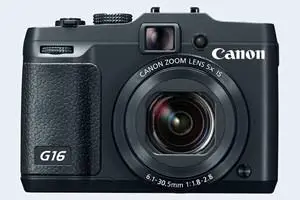Canon 6D vs G16
The Canon EOS 6D and the Canon PowerShot G16 are two digital cameras that were revealed to the public, respectively, in September 2012 and August 2013. The 6D is a DSLR, while the G16 is a fixed lens compact. The cameras are based on a full frame (6D) and a 1/1.7-inch (G16) sensor. The 6D has a resolution of 20 megapixels, whereas the G16 provides 12 MP.
Below is an overview of the main specs of the two cameras as a starting point for the comparison.

Check 6D offers at
ebay.com

Check G16 offers at
ebay.com
Going beyond this snapshot of core features and characteristics, what are the differences between the Canon EOS 6D and the Canon PowerShot G16? Which one should you buy? Read on to find out how these two cameras compare with respect to their body size, their imaging sensors, their shooting features, their input-output connections, and their reception by expert reviewers.
Body comparison
The side-by-side display below illustrates the physical size and weight of the Canon 6D and the Canon G16. The two cameras are presented according to their relative size. Three consecutive views from the front, the top, and the rear side are shown. All width, height and depth dimensions are rounded to the nearest millimeter.
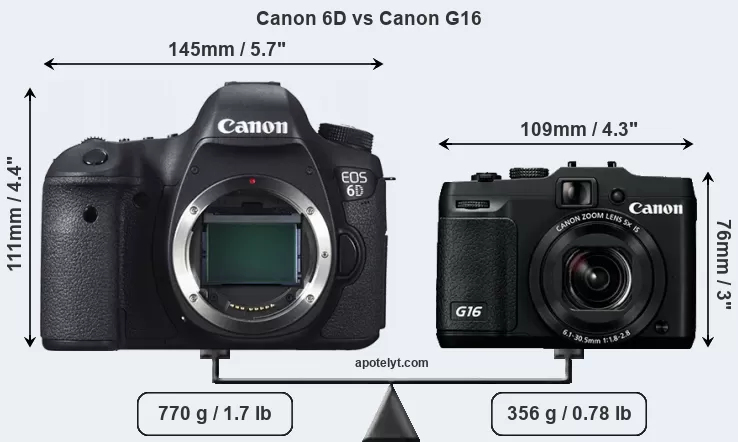

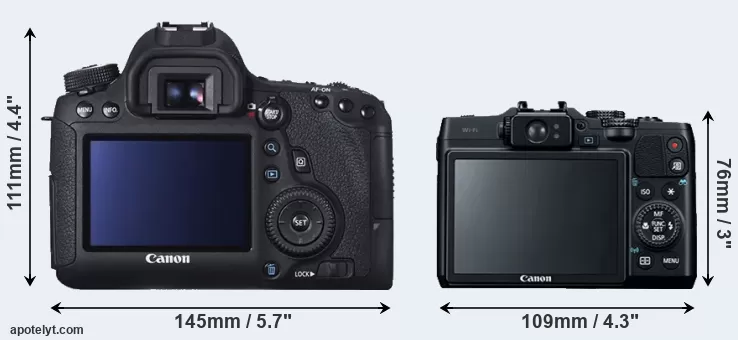
If the front view area (width x height) of the cameras is taken as an aggregate measure of their size, the Canon G16 is considerably smaller (49 percent) than the Canon 6D. It is worth mentioning in this context that the 6D is splash and dust resistant, while the G16 does not feature any corresponding weather-sealing.
The above size and weight comparisons are to some extent incomplete and possibly misleading, as the G16 has a lens built in, whereas the 6D is an interchangeable lens camera that requires a separate lens. Attaching the latter will add extra weight and bulk to the setup. You can compare the optics available for the 6D and their specifications in the Canon EF Lens Catalog.
Concerning battery life, the 6D gets 1090 shots out of its Canon LP-E6 battery, while the G16 can take 360 images on a single charge of its Canon NB-10L power pack.
The adjacent table lists the principal physical characteristics of the two cameras alongside a wider set of alternatives. If you would like to visualize and compare a different camera combination, you can navigate to the CAM-parator app and make your selection from a broad list of cameras there.

| Camera Model |
Camera Width |
Camera Height |
Camera Depth |
Camera Weight |
Battery Life |
Weather Sealing |
Camera Launch |
Launch Price (USD) |
Street Price |
||
|---|---|---|---|---|---|---|---|---|---|---|---|
| 1. | Canon 6D | 145 mm | 111 mm | 71 mm | 770 g | 1090 | Y | Sep 2012 | 2,099 | ebay.com | |
| 2. | Canon G16 | 109 mm | 76 mm | 40 mm | 356 g | 360 | n | Aug 2013 | 549 | ebay.com | |
| 3. | Canon 1D X | 158 mm | 168 mm | 83 mm | 1551 g | 1120 | Y | Oct 2011 | 6,799 | ebay.com | |
| 4. | Canon 1D X Mark II | 158 mm | 168 mm | 83 mm | 1530 g | 1210 | Y | Feb 2016 | 5,999 | ebay.com | |
| 5. | Canon 5D Mark II | 152 mm | 114 mm | 75 mm | 850 g | 850 | Y | Sep 2008 | 3,499 | ebay.com | |
| 6. | Canon 5D Mark III | 152 mm | 116 mm | 76 mm | 950 g | 950 | Y | Mar 2012 | 3,499 | ebay.com | |
| 7. | Canon 5DS | 152 mm | 116 mm | 76 mm | 930 g | 700 | Y | Feb 2015 | 3,699 | ebay.com | |
| 8. | Canon 6D Mark II | 144 mm | 111 mm | 75 mm | 765 g | 1200 | Y | Jun 2017 | 1,999 | amazon.com | |
| 9. | Canon 7D II | 149 mm | 112 mm | 78 mm | 910 g | 670 | Y | Sep 2014 | 1,799 | ebay.com | |
| 10. | Canon 70D | 139 mm | 104 mm | 79 mm | 755 g | 920 | Y | Jul 2013 | 1,199 | ebay.com | |
| 11. | Canon G12 | 112 mm | 76 mm | 48 mm | 401 g | 370 | n | Sep 2010 | 499 | ebay.com | |
| 12. | Canon G15 | 107 mm | 76 mm | 40 mm | 352 g | 350 | n | Sep 2012 | 499 | ebay.com | |
| 13. | Canon SL1 | 117 mm | 91 mm | 69 mm | 407 g | 380 | n | Mar 2013 | 549 | ebay.com | |
| 14. | Nikon D600 | 141 mm | 113 mm | 82 mm | 850 g | 900 | Y | Sep 2012 | 2,099 | ebay.com | |
| 15. | Nikon D610 | 141 mm | 113 mm | 82 mm | 850 g | 900 | Y | Oct 2013 | 1,999 | ebay.com | |
| 16. | Nikon P7800 | 119 mm | 78 mm | 50 mm | 399 g | 350 | n | Sep 2013 | 549 | ebay.com | |
| 17. | Panasonic LX7 | 111 mm | 68 mm | 46 mm | 298 g | 330 | n | Jul 2012 | 499 | ebay.com | |
| Note: Measurements and pricing do not include easily detachable parts, such as add-on or interchangeable lenses or optional viewfinders. | |||||||||||
The price is, of course, an important factor in any camera decision. The retail prices at the time of the camera’s release place the model in the market relative to other models in the producer’s line-up and the competition. The G16 was launched at a lower price than the 6D, despite having a lens built in. Normally, street prices remain initially close to the MSRP, but after a couple of months, the first discounts appear. Later in the product cycle and, in particular, when the replacement model is about to appear, further discounting and stock clearance sales often push the camera price considerably down. Then, after the new model is out, very good deals can frequently be found on the pre-owned market.
Sensor comparison
The imaging sensor is at the core of digital cameras and its size is one of the main determining factors of image quality. A large sensor will generally have larger individual pixels that offer better low-light sensitivity, provide wider dynamic range, and have richer color-depth than smaller pixels in a sensor of the same technological generation. Further, a large sensor camera will give the photographer additional creative options when using shallow depth-of-field to isolate a subject from its background. On the downside, larger sensors are more costly to manufacture and tend to lead to bigger and heavier cameras and lenses.
Of the two cameras under consideration, the Canon 6D features a full frame sensor and the Canon G16 a 1/1.7-inch sensor. The sensor area in the G16 is 95 percent smaller. As a result of these sensor size differences, the cameras have a format factor of, respectively, 1.0 and 4.65. The sensor in the 6D has a native 3:2 aspect ratio, while the one in the G16 offers a 4:3 aspect.
Technology-wise, the G16 uses a more advanced image processing engine (DIGIC 6) than the 6D (DIGIC 5+), with benefits for noise reduction, color accuracy, and processing speed.
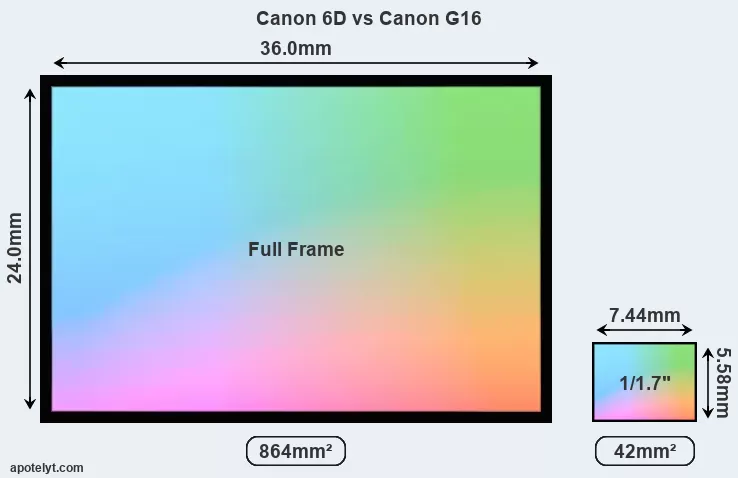
With 20MP, the 6D offers a higher resolution than the G16 (12MP), but the 6D nevertheless has larger individual pixels (pixel pitch of 6.57μm versus 1.87μm for the G16) due to its larger sensor. However, the G16 is a somewhat more recent model (by 11 months) than the 6D, and its sensor might have benefitted from technological advances during this time that enhance the light gathering capacity of its pixels.
The resolution advantage of the Canon 6D implies greater flexibility for cropping images or the possibility to print larger pictures. The maximum print size of the 6D for good quality output (200 dots per inch) amounts to 27.4 x 18.2 inches or 69.5 x 46.3 cm, for very good quality (250 dpi) 21.9 x 14.6 inches or 55.6 x 37.1 cm, and for excellent quality (300 dpi) 18.2 x 12.2 inches or 46.3 x 30.9 cm. The corresponding values for the Canon G16 are 20 x 15 inches or 50.8 x 38.1 cm for good quality, 16 x 12 inches or 40.6 x 30.5 cm for very good quality, and 13.3 x 10 inches or 33.9 x 25.4 cm for excellent quality prints.
The Canon EOS 6D has a native sensitivity range from ISO 100 to ISO 25600, which can be extended to ISO 50-102400. The corresponding ISO settings for the Canon PowerShot G16 are ISO 80 to ISO 12800 (no boost).
In terms of underlying technology, the 6D is build around a CMOS sensor, while the G16 uses a BSI-CMOS imager. Both cameras use a Bayer filter for capturing RGB colors on a square grid of photosensors. This arrangement is found in most digital cameras.
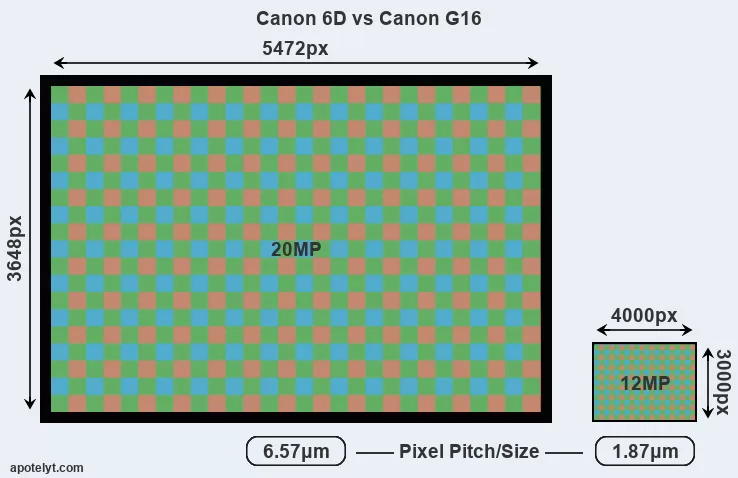
Since 2007, DXO Mark has published sensor performance measurements that have been derived using a consistent methodology. This service assesses and scores the color depth ("DXO Portrait"), dynamic range ("DXO Landscape"), and low-light sensitivity ("DXO Sports") of camera sensors, and also publishes an overall camera score. Of the two cameras under review, the 6D provides substantially higher image quality than the G16, with an overall score that is 28 points higher. This advantage is based on 2.8 bits higher color depth, 0.4 EV in additional dynamic range, and 3.3 stops in additional low light sensitivity. The adjacent table reports on the physical sensor characteristics and the outcomes of the DXO sensor quality tests for a sample of comparator-cameras.

| Camera Model |
Sensor Class |
Resolution (MP) |
Horiz. Pixels |
Vert. Pixels |
Video Format |
DXO Portrait |
DXO Landscape |
DXO Sports |
DXO Overall |
||
|---|---|---|---|---|---|---|---|---|---|---|---|
| 1. | Canon 6D | Full Frame | 20.0 | 5472 | 3648 | 1080/30p | 23.8 | 12.1 | 2340 | 82 | |
| 2. | Canon G16 | 1/1.7 | 12.0 | 4000 | 3000 | 1080/60p | 21.0 | 11.7 | 230 | 54 | |
| 3. | Canon 1D X | Full Frame | 17.9 | 5184 | 3456 | 1080/30p | 23.8 | 11.8 | 2786 | 82 | |
| 4. | Canon 1D X Mark II | Full Frame | 20.0 | 5472 | 3648 | 4K/60p | 24.1 | 13.5 | 3207 | 88 | |
| 5. | Canon 5D Mark II | Full Frame | 21.0 | 5616 | 3744 | 1080/30p | 23.7 | 11.9 | 1815 | 79 | |
| 6. | Canon 5D Mark III | Full Frame | 22.1 | 5760 | 3840 | 1080/30p | 24.0 | 11.7 | 2293 | 81 | |
| 7. | Canon 5DS | Full Frame | 50.3 | 8688 | 5792 | 1080/30p | 24.7 | 12.4 | 2381 | 87 | |
| 8. | Canon 6D Mark II | Full Frame | 26.0 | 6240 | 4160 | 1080/60p | 24.4 | 11.9 | 2862 | 85 | |
| 9. | Canon 7D II | APS-C | 20.0 | 5472 | 3648 | 1080/60p | 22.4 | 11.8 | 1082 | 70 | |
| 10. | Canon 70D | APS-C | 20.0 | 5472 | 3648 | 1080/30p | 22.5 | 11.6 | 926 | 68 | |
| 11. | Canon G12 | 1/1.7 | 10.0 | 3648 | 2736 | 720/24p | 20.4 | 11.2 | 161 | 47 | |
| 12. | Canon G15 | 1/1.7 | 12.0 | 4000 | 3000 | 1080/24p | 19.9 | 11.5 | 165 | 46 | |
| 13. | Canon SL1 | APS-C | 17.9 | 5184 | 3456 | 1080/30p | 21.8 | 11.3 | 843 | 63 | |
| 14. | Nikon D600 | Full Frame | 24.2 | 6016 | 4016 | 1080/30p | 25.1 | 14.2 | 2980 | 94 | |
| 15. | Nikon D610 | Full Frame | 24.2 | 6016 | 4016 | 1080/30p | 25.1 | 14.4 | 2925 | 94 | |
| 16. | Nikon P7800 | 1/1.7 | 12.0 | 4000 | 3000 | 1080/30p | 21.2 | 11.7 | 200 | 54 | |
| 17. | Panasonic LX7 | 1/1.7 | 10.0 | 3648 | 2736 | 1080/60p | 20.7 | 11.7 | 147 | 50 |
Many modern cameras cannot only take still pictures, but also record videos. Both cameras under consideration have a sensor with sufficiently fast read-out times for moving pictures, but the G16 provides a faster frame rate than the 6D. It can shoot movie footage at 1080/60p, while the 6D is limited to 1080/30p.
Feature comparison
Apart from body and sensor, cameras can and do differ across a variety of features. The 6D and the G16 are similar in the sense that both have an optical viewfinder. The latter is useful for getting a clear image for framing even in brightly lit environments. The following table reports on some other key feature differences and similarities of the Canon 6D, the Canon G16, and comparable cameras.

| Camera Model |
Viewfinder (Type or 000 dots) |
Control Panel (yes/no) |
LCD Specifications (inch/000 dots) |
LCD Attach- ment |
Touch Screen (yes/no) |
Max Shutter Speed * |
Max Shutter Flaps * |
Built-in Flash (yes/no) |
Built-in Image Stab |
||
|---|---|---|---|---|---|---|---|---|---|---|---|
| 1. | Canon 6D | optical | Y | 3.0 / 1040 | fixed | n | 1/4000s | 4.5/s | n | n | |
| 2. | Canon G16 | optical | n | 3.0 / 922 | fixed | n | 1/4000s | 2.2/s | Y | Y | |
| 3. | Canon 1D X | optical | Y | 3.2 / 1040 | fixed | n | 1/8000s | 14.0/s | n | n | |
| 4. | Canon 1D X Mark II | optical | Y | 3.2 / 1620 | fixed | Y | 1/8000s | 16.0/s | n | n | |
| 5. | Canon 5D Mark II | optical | Y | 3.0 / 920 | fixed | n | 1/8000s | 3.9/s | n | n | |
| 6. | Canon 5D Mark III | optical | Y | 3.2 / 1040 | fixed | n | 1/8000s | 6.0/s | n | n | |
| 7. | Canon 5DS | optical | Y | 3.2 / 1040 | fixed | n | 1/8000s | 5.0/s | n | n | |
| 8. | Canon 6D Mark II | optical | Y | 3.0 / 1040 | swivel | Y | 1/4000s | 6.5/s | n | n | |
| 9. | Canon 7D II | optical | Y | 3.0 / 1040 | fixed | n | 1/8000s | 10.0/s | Y | n | |
| 10. | Canon 70D | optical | Y | 3.0 / 1040 | swivel | Y | 1/8000s | 7.0/s | Y | n | |
| 11. | Canon G12 | optical | n | 2.8 / 461 | swivel | n | 1/4000s | 1.1/s | Y | Y | |
| 12. | Canon G15 | optical | n | 3.0 / 922 | fixed | n | 1/4000s | 2.1/s | Y | Y | |
| 13. | Canon SL1 | optical | n | 3.0 / 1040 | fixed | Y | 1/4000s | 4.9/s | Y | n | |
| 14. | Nikon D600 | optical | Y | 3.0 / 921 | fixed | n | 1/4000s | 5.5/s | Y | n | |
| 15. | Nikon D610 | optical | Y | 3.2 / 921 | fixed | n | 1/4000s | 6.0/s | Y | n | |
| 16. | Nikon P7800 | 921 | n | 3.0 / 921 | swivel | n | 1/4000s | 8.0/s | Y | Y | |
| 17. | Panasonic LX7 | optional | n | 3.0 / 920 | fixed | n | 1/4000s | 11.0/s | Y | Y | |
| Note: *) Information refers to the mechanical shutter, unless the camera only has an electronic one. | |||||||||||
One feature that is present on the 6D, but is missing on the G16 is a top-level LCD. While being, of course, smaller than the rear screen, the control panel conveys some of the essential shooting information and can be convenient for quick and easy settings verification.
The Canon G16 has an intervalometer built-in. This enables the photographer to capture time lapse sequences, such as flower blooming, a sunset or moon rise, without purchasing an external camera trigger and related software.
Concerning the storage of imaging data, both the 6D and the G16 write their files to SDXC cards. Both cameras can use UHS-I cards, which provide for Ultra High Speed data transfer of up to 104 MB/s.
Connectivity comparison
For some imaging applications, the extent to which a camera can communicate with its environment can be an important aspect in the camera decision process. The table below provides an overview of the connectivity of the Canon EOS 6D and Canon PowerShot G16 and, in particular, the interfaces the cameras (and selected comparators) provide for accessory control and data transfer.

| Camera Model |
Hotshoe Port |
Internal Mic / Speaker |
Microphone Port |
Headphone Port |
HDMI Port |
USB Port |
WiFi Support |
NFC Support |
Bluetooth Support |
||
|---|---|---|---|---|---|---|---|---|---|---|---|
| 1. | Canon 6D | Y | mono / mono | Y | - | mini | 2.0 | Y | - | - | |
| 2. | Canon G16 | Y | stereo / mono | - | - | mini | 2.0 | Y | - | - | |
| 3. | Canon 1D X | Y | mono / - | Y | - | mini | 2.0 | - | - | - | |
| 4. | Canon 1D X Mark II | Y | mono / mono | Y | Y | mini | 3.0 | - | - | - | |
| 5. | Canon 5D Mark II | Y | mono / mono | Y | - | mini | 2.0 | - | - | - | |
| 6. | Canon 5D Mark III | Y | mono / mono | Y | Y | mini | 2.0 | - | - | - | |
| 7. | Canon 5DS | Y | mono / mono | Y | - | mini | 3.0 | - | - | - | |
| 8. | Canon 6D Mark II | Y | stereo / mono | Y | - | mini | 2.0 | Y | Y | Y | |
| 9. | Canon 7D II | Y | stereo / mono | Y | Y | mini | 3.0 | - | - | - | |
| 10. | Canon 70D | Y | stereo / mono | Y | - | mini | 2.0 | Y | - | - | |
| 11. | Canon G12 | Y | stereo / mono | - | - | mini | 2.0 | - | - | - | |
| 12. | Canon G15 | Y | stereo / mono | - | - | mini | 2.0 | - | - | - | |
| 13. | Canon SL1 | Y | mono / mono | Y | - | mini | 2.0 | - | - | - | |
| 14. | Nikon D600 | Y | mono / mono | Y | Y | mini | 2.0 | - | - | - | |
| 15. | Nikon D610 | Y | mono / mono | Y | Y | mini | 2.0 | - | - | - | |
| 16. | Nikon P7800 | Y | stereo / mono | Y | - | mini | 2.0 | - | - | - | |
| 17. | Panasonic LX7 | Y | stereo / mono | - | - | mini | 2.0 | - | - | - |
It is notable that the 6D has a microphone port, which is missing on the G16. Such an external microphone input can help to substantially improve the quality of audio recordings when a good external microphone is used.
Travel and landscape photographers will find it useful that the 6D has an internal geolocalization sensor and can record GPS coordinates in its EXIF data.
Both the 6D and the G16 have been discontinued, but can regularly be found used on ebay. The 6D was replaced by the Canon 6D Mark II, while the G16 does not have a direct successor. Further information on the features and operation of the 6D and G16 can be found, respectively, in the Canon 6D Manual (free pdf) or the online Canon G16 Manual.
Review summary
So what conclusions can be drawn? Which of the two cameras – the Canon 6D or the Canon G16 – has the upper hand? Is one clearly better than the other? The listing below highlights the relative strengths of the two models.
Reasons to prefer the Canon EOS 6D:
- More detail: Offers more megapixels (20 vs 12MP) with a 32% higher linear resolution.
- Better image quality: Scores substantially higher (28 points) in the DXO overall assessment.
- Richer colors: Generates images with noticeably better colors (2.8 bits more color depth).
- Better low-light sensitivity: Requires less light for good images (3.3 stops ISO advantage).
- Better sound: Can connect to an external microphone for higher quality sound recording.
- Easier setting verification: Features an LCD display on top to control shooting parameters.
- More detailed LCD: Has a higher resolution rear screen (1040k vs 922k dots).
- Faster burst: Shoots at higher frequency (4.5 vs 2.2 flaps/sec) to capture the decisive moment.
- More flexible: Can take a variety of interchangeable lenses, including specialty optics.
- Longer lasting: Can take more shots (1090 versus 360) on a single battery charge.
- Better sealing: Is weather sealed to enable shooting in dusty or wet environments.
- Easier geotagging: Features an internal GPS sensor to log localization data.
- More heavily discounted: Has been on the market for longer (launched in September 2012).
Arguments in favor of the Canon PowerShot G16:
- Better jpgs: Has a more modern image processing engine (DIGIC 6 vs DIGIC 5+).
- Better video: Provides higher movie framerates (1080/60p versus 1080/30p).
- Easier time-lapse photography: Has an intervalometer built-in for low frequency shooting.
- Ready to shoot: Comes with an integrated lens, while the 6D requires a separate lens.
- More compact: Is smaller (109x76mm vs 145x111mm) and will fit more readily into a bag.
- Less heavy: Has a lower weight even though it has a lens built in (unlike the 6D).
- Sharper images: Has stabilization technology built-in to reduce the impact of hand-shake.
- Easier fill-in: Has a small integrated flash to brighten shadows of backlit subjects.
- More affordable: Was introduced at a lower price, despite coming with a built-in lens.
- More modern: Was introduced somewhat (11 months) more recently.
If the count of individual advantages (bullet points above) is taken as a guide, the 6D emerges as the winner of the contest (13 : 10 points). However, the pertinence of the various camera strengths will differ across photographers, so that you might want to weigh individual camera traits according to their importance for your own imaging needs before making a camera decision. A professional wildlife photographer will view the differences between cameras in a way that diverges from the perspective of a family photog, and a person interested in architecture has distinct needs from a sports shooter. Hence, the decision which camera is best and worth buying is often a very personal one.
How about other alternatives? Do the specifications of the Canon 6D and the Canon G16 place the cameras among the top in their class? Find out in the latest Best DSLR Camera and Best Travel-Zoom Camera listings whether the two cameras rank among the cream of the crop.
In any case, while the comparison of the spec-sheets of cameras can offer a general idea of their imaging potential, it remains incomplete and does no justice, for example, to the way the 6D or the G16 perform in practice. User reviews that are available, for instance, at amazon can sometimes shed light on these issues, but such feedback is all too often partial, inconsistent, and inaccurate.
Expert reviews
This is why expert reviews are important. The adjacent summary-table relays the overall verdicts of several of the most popular camera review sites (amateurphotographer [AP], cameralabs [CL], digitalcameraworld [DCW], dpreview [DPR], ephotozine [EPZ], photographyblog [PB]). As can be seen, the professional reviewers agree in many cases on the quality of different cameras, but sometimes their assessments diverge, reinforcing the earlier point that a camera decision is often a very personal choice.

| Camera Model |
AP score |
CL score |
DCW score |
DPR score |
EPZ score |
PB score |
Camera Launch |
Launch Price (USD) |
Street Price |
||
|---|---|---|---|---|---|---|---|---|---|---|---|
| 1. | Canon 6D | 5/5 | + + | .. | 83/100 | 4.5/5 | 4.5/5 | Sep 2012 | 2,099 | ebay.com | |
| 2. | Canon G16 | 4/5 | + | .. | .. | 4.5/5 | 4.5/5 | Aug 2013 | 549 | ebay.com | |
| 3. | Canon 1D X | 5/5 | .. | .. | .. | 4.5/5 | 4.5/5 | Oct 2011 | 6,799 | ebay.com | |
| 4. | Canon 1D X Mark II | .. | .. | 4.5/5 | 89/100 | 4.5/5 | 4.5/5 | Feb 2016 | 5,999 | ebay.com | |
| 5. | Canon 5D Mark II | 4/5 | 91/100 | .. | 79/100 | 4/5 | .. | Sep 2008 | 3,499 | ebay.com | |
| 6. | Canon 5D Mark III | .. | + + | .. | 82/100 | 4.5/5 | 4.5/5 | Mar 2012 | 3,499 | ebay.com | |
| 7. | Canon 5DS | .. | + | .. | 83/100 | 4.5/5 | 4.5/5 | Feb 2015 | 3,699 | ebay.com | |
| 8. | Canon 6D Mark II | 4/5 | + | 4/5 | 80/100 | 4.5/5 | 4/5 | Jun 2017 | 1,999 | amazon.com | |
| 9. | Canon 7D II | 4.5/5 | + | 3.5/5 | 84/100 | 4/5 | 4.5/5 | Sep 2014 | 1,799 | ebay.com | |
| 10. | Canon 70D | 5/5 | + + | .. | 83/100 | 4.5/5 | 5/5 | Jul 2013 | 1,199 | ebay.com | |
| 11. | Canon G12 | 4/5 | + | .. | 73/100 | 4.5/5 | 4.5/5 | Sep 2010 | 499 | ebay.com | |
| 12. | Canon G15 | 4/5 | + | .. | 76/100 | 4.5/5 | 4.5/5 | Sep 2012 | 499 | ebay.com | |
| 13. | Canon SL1 | 4/5 | + | .. | 78/100 | 4/5 | 4/5 | Mar 2013 | 549 | ebay.com | |
| 14. | Nikon D600 | 4/5 | + + | .. | 87/100 | 5/5 | 4.5/5 | Sep 2012 | 2,099 | ebay.com | |
| 15. | Nikon D610 | 4/5 | + + | .. | 87/100 | 4.5/5 | 4.5/5 | Oct 2013 | 1,999 | ebay.com | |
| 16. | Nikon P7800 | 3/5 | .. | .. | .. | 4/5 | 4.5/5 | Sep 2013 | 549 | ebay.com | |
| 17. | Panasonic LX7 | 3/5 | + + | .. | 75/100 | 4/5 | 4.5/5 | Jul 2012 | 499 | ebay.com | |
| Note: (+ +) highly recommended; (+) recommended; (o) reviewed; (..) not available. | |||||||||||
The above review scores should be interpreted with care, though. The ratings were established in reference to similarly priced cameras that were available in the market at the time of the review. A score, therefore, has to be seen in close connection to the price and market introduction time of the camera, and comparing ratings of very distinct cameras or ones that are far apart in terms of their release date have little meaning. Also, please note that some of the review sites have changed their methodology and reporting over time.

Check 6D offers at
ebay.com

Check G16 offers at
ebay.com
Other camera comparisons
Did this review help to inform your camera decision process? In case you would like to check on the differences and similarities of other camera models, just make your choice using the following search menu. There is also a set of direct links to comparison reviews that other users of the CAM-parator app explored.
Specifications: Canon 6D vs Canon G16
Below is a side-by-side comparison of the specs of the two cameras to facilitate a quick review of their differences and common features.
| Camera Model | Canon 6D | Canon G16 |
|---|---|---|
| Camera Type | Digital single lens reflex | Fixed lens compact camera |
| Camera Lens | Canon EF mount lenses | 28-140mm f/1.8-2.8 |
| Launch Date | September 2012 | August 2013 |
| Launch Price | USD 2,099 | USD 549 |
| Sensor Specs | Canon 6D | Canon G16 |
| Sensor Technology | CMOS | BSI-CMOS |
| Sensor Format | Full Frame Sensor | 1/1.7" Sensor |
| Sensor Size | 36.0 x 24.0 mm | 7.44 x 5.58 mm |
| Sensor Area | 864 mm2 | 41.5152 mm2 |
| Sensor Diagonal | 43.3 mm | 9.3 mm |
| Crop Factor | 1.0x | 4.65x |
| Sensor Resolution | 20 Megapixels | 12 Megapixels |
| Image Resolution | 5472 x 3648 pixels | 4000 x 3000 pixels |
| Pixel Pitch | 6.57 μm | 1.87 μm |
| Pixel Density | 2.31 MP/cm2 | 28.91 MP/cm2 |
| Moiré control | Anti-Alias filter | Anti-Alias filter |
| Movie Capability | 1080/30p Video | 1080/60p Video |
| ISO Setting | 100 - 25,600 ISO | 80 - 12,800 ISO |
| ISO Boost | 50 - 102,400 ISO | no Enhancement |
| Image Processor | DIGIC 5+ | DIGIC 6 |
| DXO Sensor Quality (score) | 82 | 54 |
| DXO Color Depth (bits) | 23.8 | 21.0 |
| DXO Dynamic Range (EV) | 12.1 | 11.7 |
| DXO Low Light (ISO) | 2340 | 230 |
| Screen Specs | Canon 6D | Canon G16 |
| Viewfinder Type | Optical viewfinder | Optical viewfinder |
| Viewfinder Field of View | 97% | 80% |
| Viewfinder Magnification | 0.71x | |
| Top-Level Screen | Control Panel | no Top Display |
| LCD Framing | Live View | Live View |
| Rear LCD Size | 3.0inch | 3.0inch |
| LCD Resolution | 1040k dots | 922k dots |
| LCD Attachment | Fixed screen | Fixed screen |
| Shooting Specs | Canon 6D | Canon G16 |
| Focus System | Phase-detect AF | Contrast-detect AF |
| Manual Focusing Aid | no Peaking Feature | Focus Peaking |
| Max Shutter Speed (mechanical) | 1/4000s | 1/4000s |
| Continuous Shooting | 4.5 shutter flaps/s | 2.2 shutter flaps/s |
| Time-Lapse Photography | no Intervalometer | Intervalometer built-in |
| Fill Flash | no On-Board Flash | Built-in Flash |
| Storage Medium | SDXC cards | SDXC cards |
| Single or Dual Card Slots | Single card slot | Single card slot |
| UHS card support | UHS-I | UHS-I |
| Connectivity Specs | Canon 6D | Canon G16 |
| External Flash | Hotshoe | Hotshoe |
| USB Connector | USB 2.0 | USB 2.0 |
| HDMI Port | mini HDMI | mini HDMI |
| Microphone Port | External MIC port | no MIC socket |
| Wifi Support | Wifi built-in | Wifi built-in |
| Geotagging | GPS built-in | no internal GPS |
| Body Specs | Canon 6D | Canon G16 |
| Environmental Sealing | Weathersealed body | not weather sealed |
| Battery Type | Canon LP-E6 | Canon NB-10L |
| Battery Life (CIPA) | 1090 shots per charge | 360 shots per charge |
| Body Dimensions |
145 x 111 x 71 mm (5.7 x 4.4 x 2.8 in) |
109 x 76 x 40 mm (4.3 x 3.0 x 1.6 in) |
| Camera Weight | 770 g (27.2 oz) | 356 g (12.6 oz) |

Check 6D offers at
ebay.com

Check G16 offers at
ebay.com
Did you notice an error on this page? If so, please get in touch, so that we can correct the information.
